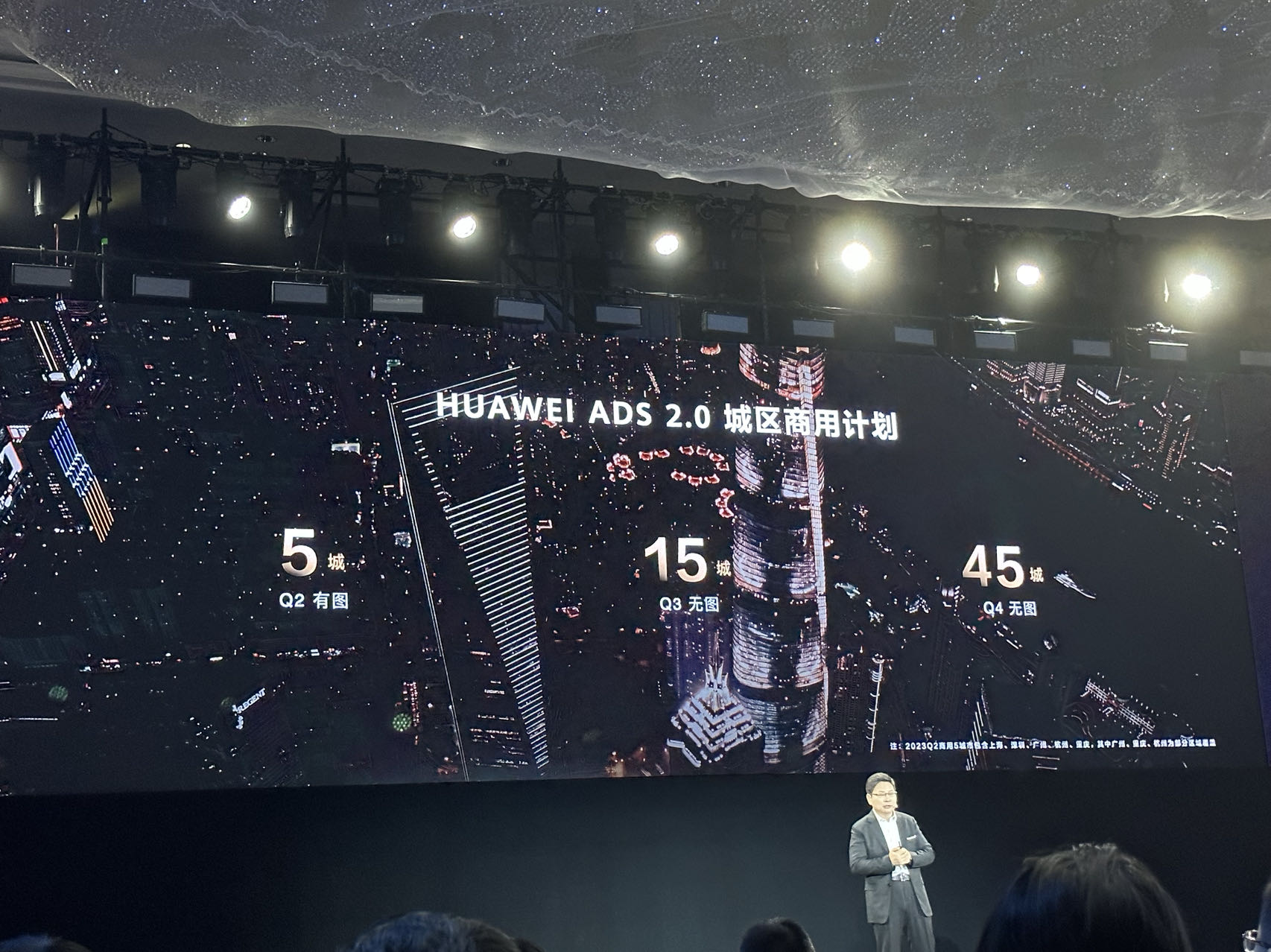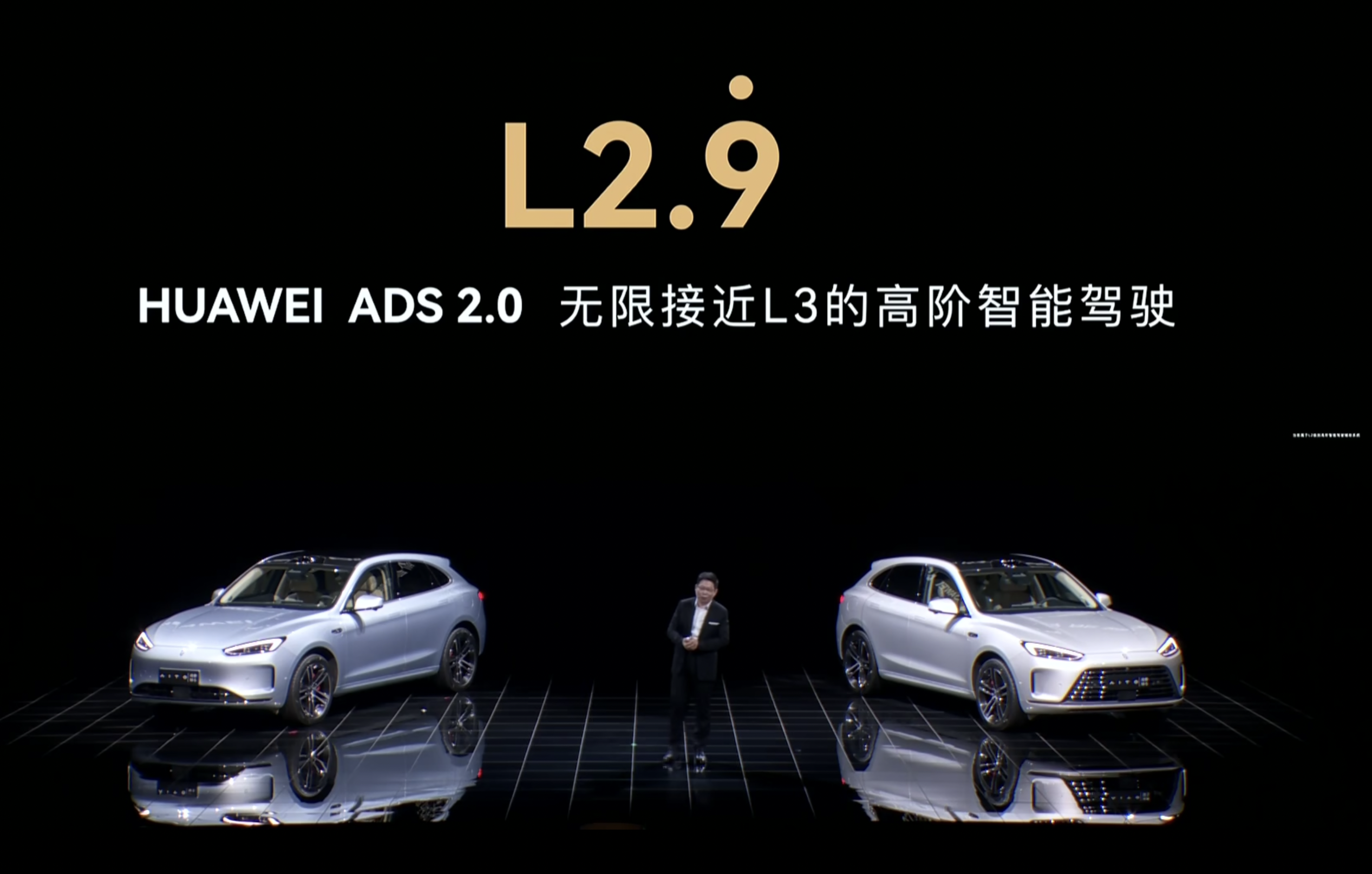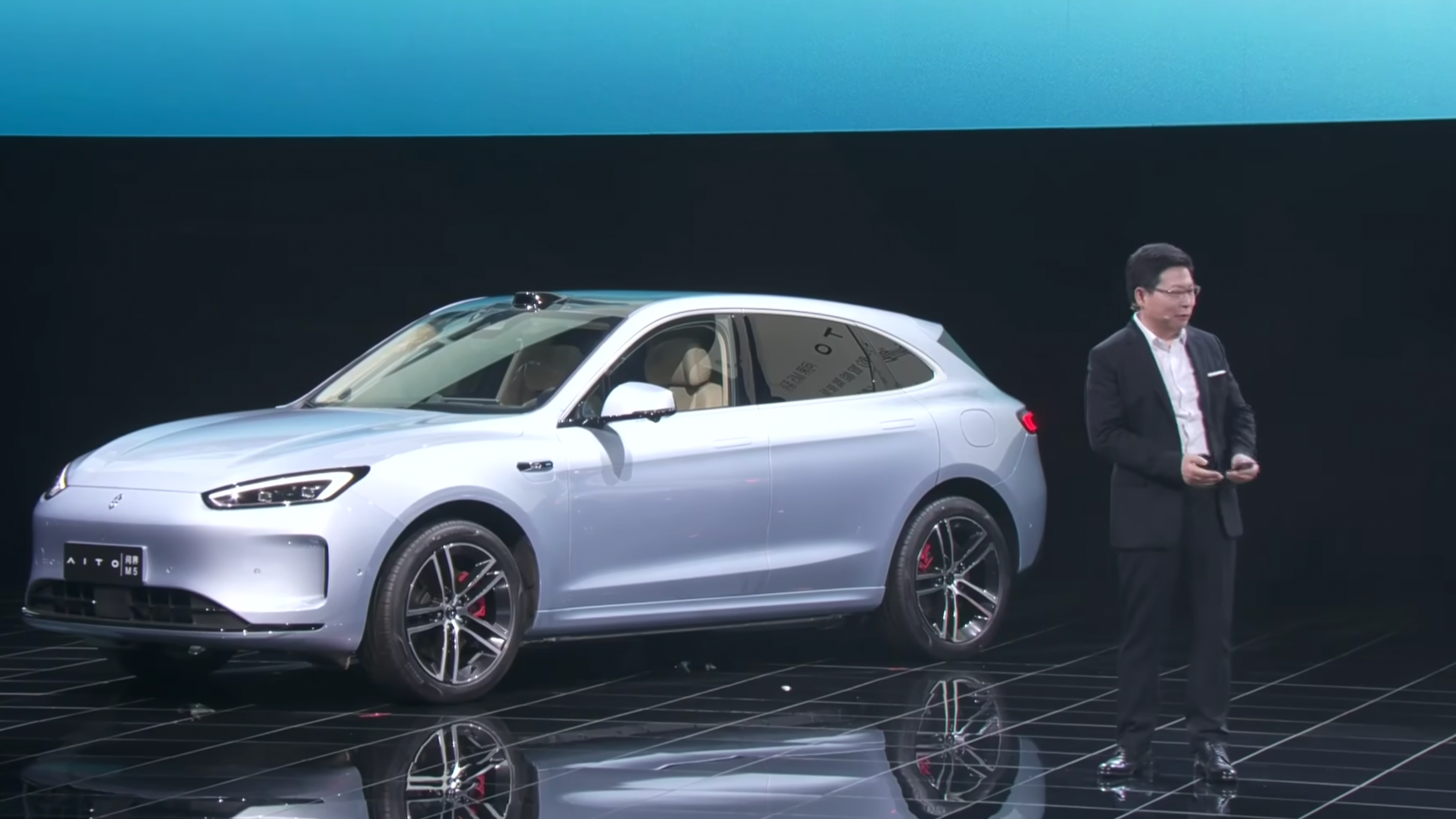During and after the Shanghai Auto Show, Yu Chengdong, the Executive Director of Huawei, CEO of Huawei’s Consumer Business Group (CBG), CEO of Huawei’s Intelligent Automotive Solution Business Unit (IAS BU), was very busy. Before the auto show opened, he spent a morning accompanying Tan Sir to experience Huawei’s advanced intelligent assisted driving system (ADS) 2.0 in Shanghai and meeting college students. During the following two days, he respectively lectured at the Huawei Intelligent Automotive Solution launch event and the Wensen M5 new car launch event, during which the phrase “far ahead” appeared multiple times.
After the auto show opened, Yu Chengdong appeared on time at the Huawei booth as mentioned, meeting with leaders in various automobile companies such as Mercedes-Benz, BMW, Audi, and so on, and was extremely busy.
Despite this, during the exhibition, we unexpectedly ran into Yu Chengdong and had a brief conversation with him during his break, and by communicating with other industry insiders, we gained new insight into some key issues in Huawei’s intelligent automotive business.
In summary, Yu Chengdong is really busy.
What is Yu Chengdong’s consideration in promoting intelligent selection cars?
After entering the intelligent automotive industry, Huawei mainly operates in three modes:
- Standard Parts mode. This mode mainly sells standard parts for automobile intelligence such as computing chips and LIDAR.
- HI mode. In this mode, Huawei mainly provides intelligent driving and other solutions, but the product design and experience are controlled by the car company.
- Intelligent Selection Cars mode. In this mode, Huawei provides a full-stack solution, including product definition, design, brand marketing, channel sales, and so on. This mode is similar to Huawei and the car company jointly manufacturing cars, and currently, the deepest cooperation is with Cyrus.
However, the Intelligent Selection Cars mode has become the core mode that Yu Chengdong promotes.
An industry insider familiar with Huawei explained that the reason is quite simple. For Huawei, the value generated by the Standard Parts mode is not high, and there are many competitors in this area. Huawei’s parts prices are not advantageous, so many car companies do not necessarily need to purchase Huawei’s parts.
As for the HI mode, the insider stated that the only car company that insists on the HI mode is Avita under Changan Automobile, which provides Huawei’s intelligent driving, intelligent cabin, and other solutions. However, the design of the body of the car is still dominated by Changan. Guangzhou Automobile Group has abandoned joint development and switched to a parts procurement model, and although Beijing Automotive Group was Huawei’s earliest partner, the sales were not good, and the cooperation regarding HI mode between the two is no longer exists.At the auto show, Yu Chengdong also told us that the cooperation between Huawei and BAIC has now been upgraded from HI mode to mainly Smart Car mode. As a result, in the current HI mode, Huawei only has Changan as its partner.
In fact, it is not surprising that HI mode has developed to this stage. An analyst told us that the internal motivation for car companies to choose HI mode originally depended on Huawei’s high-end brand power to create a high-end brand for the new energy era, on the premise that they had to occupy a dominant position. Therefore, there were not many car companies that could achieve cooperation. Nowadays, the effect of HI mode has been proven by time and has lost the historical conditions for further expansion on the side of the car companies.
So, from this point of view, HI mode may have completed its historical mission.
On the other hand, what Yu Chengdong vigorously promotes is actually the Smart Car mode. Currently, in addition to SAIC, Huawei’s partners in the Smart Car mode also include BAIC, Chery, and JAC.
Yu Chengdong told us that the products of these partners will not overlap in terms of product positioning, and they differ in terms of vehicle types and grades, and there will be no conflicts between them. In addition, he emphasized that these models are positioned as high-end products, because in the field of smart cars, Huawei believes that it only has the ability to make high-end products and does not have low-cost capabilities.
However, although there is no conflict in product positioning, these products from different car manufacturers may also face brand conflicts. Yu Chengdong said that he also believes that these products need to use a unified brand, otherwise there will be confusion in consumer recognition, and it will increase marketing channel costs. This issue is still under discussion and resolution.
It is worth mentioning that Yu Chengdong revealed to us that in the Smart Car mode, Huawei participates not only in product, marketing, and channel aspects, but also in the supply chain field. According to 42AUTO, in August last year, CATL announced its cooperation with SAIC and announced the landing of Kirin batteries on the AITO Wenzhe model, which involved Huawei’s participation in the supply chain.However, Yu Chengdong told us that Huawei’s participation in the supply chain is not to lower costs, but mainly to improve quality. Of course, these partners can also share resources among each other.
The Key Factors of the Development of Intelligent Driving are Cost and Implementation
At the Shanghai Auto Show, the implementation of intelligent driving became the highlight of Huawei’s Intelligent Automotive Solutions BU.
At the press conference on April 16th, Yu Chengdong announced Huawei’s advanced intelligent assisted driving HUAWEI ADS 2.0 and its price, calling it the “ceiling of intelligent driving”. The next day, HUAWEI ADS 2.0 was first installed in the latest model of M5, M5 Intelligent Driving.

It should be noted that the previously released M5 version did not use Huawei’s intelligent driving solution, but instead used Bosch’s solution for the intelligent system and Zongmu Technology’s solution for parking. However, in the M5 intelligent driving version, Huawei’s solution is adopted, so that the integrated parking and driving can be better achieved.
An industry insider told 42 Garages that in the past, Huawei’s intelligent car selection model and its cooperation with car companies were two relatively independent models. The intelligent car selection mode has always been led by Yu Chengdong, while the HI model is not directly responsible for Yu Chengdong and cannot directly intervene in the operation of the HI model at the organizational level.
However, by 2023, with Yu Chengdong’s full control over Huawei’s automotive BU, it is more advantageous for Huawei to integrate its mature HUAWEI ADS 2.0 technology into the intelligent car model. For Huawei, this means abandoning the past “two-legged walking” approach, concentrating its scattered strengths and participating more deeply in the automobile industry, aiming to form effective market sales and revenue returns.
Another industry insider told 42 Garages that the reason why Huawei has reached a consensus internally to use the intelligent driving business in the intelligent car business also has another reason. The HI mode models have not formed effective sales. BAIC Blue Valley is self-evident, while the AVITA model has relatively better performance, but its volume is not large.However, Huawei has already invested a lot of manpower and financial resources in the field of intelligent driving, with 75% of the personnel in the Huawei Intelligent Automotive Solution BU working on intelligent driving. This business cannot be sustained by the income from Huawei’s other businesses and mass landing issues must be considered.
Therefore, since the HI model is not conducive to the mass landing of Huawei’s intelligent driving business, pushing it towards the intelligent selection car model is a very logical thing to do.
Obviously, the question M5 intelligent driving version is a product of this new approach.
It is worth mentioning that, according to informed sources, under the leadership of Yu Chengdong, Huawei has not only changed its cooperation model in high-end intelligent driving but also, due to Yu Chengdong’s emphasis on product landing and experience in consumer business, he has been emphasizing the importance of cost reduction in promoting the ADS 2.0 plan.
Therefore, compared with the Avita 11 using the HI model, the number of lidars in the ADS 2.0 carried by the Question M5 intelligent driving version has been reduced from three to one, and the computing requirements have also been lowered, and the total hardware cost has been reduced by half. From the perspective of the landing of intelligent driving, this is more in line with the current industry trend of mass-scale intelligent driving landing.
Will Huawei consider giving up lidar for high-end intelligent auxiliary driving in the future?
Yu Chengdong told us that based on the current plan, it is still difficult to remove lidar to ensure the safety of intelligent driving, especially in scenarios such as tunnels. In addition, the problem of building reflection cannot be solved with a pure visual solution, and white cars are easily merged with the blue sky in such situations making it difficult for the system to identify.
He believes that Tesla’s intelligent driving is indeed very impressive, but the road it is taking is rather absolute.
It is worth mentioning that regarding L3, Yu Chengdong said that the current Huawei ADS 2.0 is currently at L2.9 and is infinitely close to L3 status but not quite L3 yet. The national regulations for L3 are still being developed, and it is expected that there will be a chance for commercial use in 2025. From L2 to L3 and then to L4 is actually a continuous evolution for current intelligent driving, and there is still a long way to go.
Yu Chengdong has emphasized that current intelligent driving can already alleviate fatigue and indeed make driving safer.
It’s a pity that Huawei chooses not to make cars
Interestingly, in the automotive industry, the phrase “far ahead” has already begun to be associated with Yu Chengdong.
Previously, Yu Chengdong repeatedly used it to emphasize the leadership of Huawei’s intelligent automotive products. Of course, from the actual feedback of the industry, at least in terms of the experience of Huawei’s intelligent cockpit and intelligent driving products, the “far ahead” in Yu Chengdong’s mouth is not arrogant talk.
Nevertheless, when the industry talks about “far ahead”, there is always a hint of ridicule in their speech. After all, the automobile industry is always about sales volume. The problem is that from the perspective of sales volume, some key models equipped with Huawei’s intelligent cockpit and intelligent driving products do not match the “far ahead”.

If sales do not go up, it means that income will not go up, which makes Yu Chengdong very anxious.
A senior industry insider close to Yu Chengdong told 42 Garage that although Huawei’s intelligent cockpit and intelligent driving solutions are very powerful, HI mode products are not selling well. In this situation, Yu Chengdong needs to consider the revenue and landing issues of the entire Huawei intelligent automotive solution BU. After all, the head of the family must consider the necessities of life.
In other words, the Huawei car BU led by Yu Chengdong has been facing profit pressures.
The senior industry insider said that automotive intelligence is indeed difficult to handle, with large investment, small output, and slow effects. This is really a thankless industry- Yu Chengdong cannot control the final landing of the product like the intelligent smartphone business, which is indeed very difficult.
So, is it possible for Huawei to become the Bosch of the automobile intelligence field?
In response to this issue, Yu Chengdong previously said at the China Electric Vehicle Hundred People’s Conference that Bosch and Huawei are doing different things. Bosch provides standard parts such as brakes, while Huawei operates at the software iteration level and needs to be deeply involved with the main factory and continuously continue OTA.A long-term industry analyst who has been studying the automotive industry told us that it is actually quite simple. Bosch’s component coverage in the automotive field is too broad, and even Bosch is also developing intelligent automotive products. However, at present, the automotive industry cannot do without Bosch. On the other hand, the automotive industry can survive without Huawei. There are many alternatives in this regard, and it is only a question of whether the experience is good or not.
However, this industry analyst also emphasized that Huawei’s entry into the automotive industry has brought many good experiences to this industry. For example, the animation effects of the Hongmeng cockpit. If Huawei did not develop intelligent car products, it would not make people realize how important the user experience of the car’s multimedia system is. Similarly, Huawei’s performance in intelligent driving has indeed set a benchmark for the development and implementation of intelligent driving in China.
“Huawei is a strong player, it is a pity that they do not make cars,” said the industry expert.
Of course, as a sanctioned company, Huawei has made a decision not to make cars with its strategic considerations. Yu Chengdong also clearly stated at the China EV100 Forum and a recent press conference that Huawei will not make cars, but help automakers make better cars.
Regarding this, a person close to Huawei’s management told us that the core reason why Huawei doesn’t make cars is that some management personnel feel that the investment in making cars is too large. Moreover, Huawei is still working hard to solve the continuity of business under U.S. sanctions, so it should not invest money in making cars. After all, not making cars will not affect Huawei’s survival.
Therefore, Yu Chengdong always considers the issues of product implementation and the closed-loop business model.
It is worth mentioning that when we asked Yu Chengdong himself about the sales expectations of the automotive industry this year, he did not take the same tone as he did at the press conference to emphasize that Huawei’s intelligent cockpit and intelligent driving products are “far ahead.” Instead, he appeared very cautious – after a little thought, he did not give a specific number, but seemed apologetic.With a gentle emphasis, she said, “This is hard to say.”
Then, she turned around and threw herself back into her work.
This article is a translation by ChatGPT of a Chinese report from 42HOW. If you have any questions about it, please email bd@42how.com.
